Experimental details
Stock solution preparation: Stock solutions of THC-COOH and THC-COOH-d3 were prepared separately in methanol at 1000 ng/mL. Blank oral fluid was spiked with the stock solution of THC-COOH to create calibrator solutions at 100000, 50000, 10000, 5000, 1000, 500, 100, 50 and 10 pg/mL. All sample concentrations are expressed as pg of THC-COOH per mL of blank oral fluid or fg of THC-COOH on column throughout this technical note, regardless of the subsequent dilutions performed.
Sample preparation: A dilute and shoot sample preparation approach was used in this experiment. In brief, 250 µL of each of the spiked oral fluid calibrator solutions was mixed with 750 µL of Quantisal stabilization buffer. The resulting solutions were then further diluted 10 times to minimize matrix effects by taking 100 µL of each solution and adding 25 µL of the 1000 ng/mL internal standard stock solution and 875 µL of a 20% methanol solution. The samples were thoroughly vortexed, centrifuged and 40 µL of the supernatant were injected for analysis. No further sample clean-up nor extraction was performed.
Liquid chromatography: HPLC separation was performed on an ExionLC™ System using a Phenomenex C18 column (50 × 2.1 mm, 2.6 µm, 00D-4475-AN) held at 40ºC equipped with a Phenomenex KrudKatcher Ultra fit (AF0-5727). Mobile phases used consisted of water, methanol and modifiers. The LC flow rate was 0.5 mL/min and the total run time was 6 min. The injection volume was 40 µL.
Mass spectrometry: A SCIEX 7500 System equipped with an OptiFlow Pro Ion Source and E Lens Technology was used. The ionization source was operated in negative electrospray ionization (ESI) mode. A looped MS experiment was performed. The first experiment consisted of five MRM transitions of 100 msec dwell time each: three for THC-COOH and two for THC-COOH-d3. The second experiment was an MRM3 scan using a scan speed of 10000 Da/s with 200 msec fill time, 25 msec excitation time and an 8V Q3 entry barrier. MRM3 data was collected as full scan data from 180 to 250 Da to simultaneously monitor the 343.1 -> 299.2-> 244.9 and the 343.1 -> 299.2 -> 191.1 MRM3 transitions. The Guided MRM3 automated compound optimization feature in SCIEX OS Software was used for optimizing the parameters for the MRM3 experiment. Six replicates of each sample were injected to build a data analysis processing method.
Data analysis: Data processing was performed using SCIEX OS Software. Quantitative analysis was performed using AutoPeak Algorithm in the Analytics module of the software where calibration curves, concentration calculations, assay precision and accuracy statistics were generated.
Combination of OptiFlow Pro Ion Source and E Lens Technology results in enhanced workflow analytical sensitivity
Accurate quantification of meaningful (pg/mL) THC-COOH levels in human oral fluid is paramount to confirm THC consumption. However, the low concentration of THC-COOH found in oral fluid of active THC users and the complexity of this matrix make detection of this metabolite challenging. As a result, developing a sensitive workflow that can accurately quantify trace levels of THC-COOH in oral fluid is critical to confirm active cannabis consumption.
The ability to accurately detect low concentration levels of THC-COOH extracted from human oral fluid was assessed using the SCIEX 7500 System. Six replicates of each of the processed calibrator samples were injected to determine the lower limit of quantification (LLOQ) value for THC-COOH and to assess the overall robustness and reproducibility of the instrument. The LLOQ value for THC-COOH was determined to be the lowest concentration calibration level meeting the following analytical performance requirements: signal-to-noise ratio (S/N) ≥10, calculated concentration accuracy within 15% of 100%, precision (%bias) below 10%, and calibrators falling on a linear calibration curve with an R2 value of at least 0.99. Detection and integration of the peaks was automatically performed using the AutoPeak Algorithm in the Analytics module of SCIEX OS Software. Analyte concentration and ion ratio were calculated automatically in the software.
Figure 2 shows the extracted ion chromatogram (XIC) traces and resulting calibration curves for two of the MRM transitions monitored for THC-COOH. The two series of XIC traces for both the quantifier and qualifier ions of THC-COOH showed a high level of sensitivity and precision across concentrations ranging from 50 to 100000 pg/mL. Eight levels of calibrators were used to determine the ion ratio criteria for the quantifier and qualifier ions of THC-COOH. The results demonstrated excellent correlation of the generated regression curves covering concentration ranges meeting the requirements of pg of THC-COOH per mL of blank oral fluid: lower limits of quantification (LLOQ) was determined to be 50 pg/mL (50 fg on column) for the quantifier ion. In addition, excellent linearity was observed across the concentration range from 50 to 100000 pg/mL for the quantifier ion and from 100 to 100000 pg/mL for the qualifier ion, with R2 values of 0.99870 and 0.99868, respectively.
A series of six replicate injections were performed to evaluate the robustness and overall performance of the SCIEX 7500 System. Table 1A summarizes the MRM results from the average (n=6) injections of each of the calibrator solutions spiked with THC-COOH and extracted from human oral fluid. The assay showed excellent precision and accuracy for concentrations ranging from 50 to 100000 pg/mL for the two THC-COOH MRM transitions monitored. All quantified samples had a %CV value below 10% and accuracy values ranging between 91.38 and 111.38%. These results demonstrate that the SCIEX 7500 System can provide robust and reproducible results even for challenging forensic workflows requiring detection of extremely low concentration levels of analytes. The performance showcased by the SCIEX 7500 System prove to be adequate to achieve the required levels of sensitivity, robustness and reproducibility required by the current workflow to accurately quantify THC-COOH down to pg/mL levels.
Improved selectivity and LLOQ using MRM3
Detecting low amounts of a metabolite present in complex biological specimen without extensive or time-consuming sample cleanup is often prone to high background and matrix interferences. In such cases, accurate quantification of specific analytes using MRM can be impaired due to the high matrix background. What typically ensues is a compromised LLOQ as the detection of these analytes is limited by signal-to-noise rather than raw instrument response. The addition of a third MS stage combining normal LIT functions with normal quadrupole functions using a novel QQQ/LIT workflow coined MRM3 can significantly reduce these background interferences while providing increased selectivity and sensitivity at the low end of the calibration curve.3 The principle of MRM3 analysis as performed on the SCIEX Triple Quad 7500 System – QTRAP Ready is shown in Figure 3.
The MRM3 quantification assay was performed on the same set of calibrator samples. Two secondary product ions of the 343.1à299.2 transition were isolated, fragmented in the linear ion trap, extracted using a width of 1 Da and summed together to produce the MRM3 signal. Figure 4 shows detection of THC-COOH at 50 pg/mL using MRM (top left) and MRM3 (top right). However, due to higher background when running the MRM assay, no signal was observable at 10 pg/mL THC-COOH (bottom left) in either of the two MRM transitions monitored. MRM3 showed much better specificity and sensitivity than the MRM data at this concentration (bottom right). As seen in Figure 4, the use of the MRM3 workflow provided much higher sensitivity compared to MRM alone due to the additional level of selectivity obtained by monitoring secondary product ions for THC-COOH in oral fluid.
The LLOQ for the MRM3 was also determined by processing the MRM3 data in SCIEX OS Software. Figure 5 shows the extracted ion chromatogram (XIC) traces and resulting calibration curves for the two secondary product ions monitored for THC-COOH. The LLOQ was determined to be 10 pg/mL (10 fg on column) for the quantifier ion. Calibration curves were also generated for the MRM3 workflow and showed excellent linearity across the concentration range from 10 to 10000 pg/mL for the quantifier ion and from 50 to 10000 pg/mL for the qualifier ion, with R2 values of 0.99782 and 0.99648, respectively. Overall, a 5-fold improvement in LLOQ was observed for the MRM3 experiment (10 pg/mL) compared to the MRM experiment (50 pg/mL). While MRM detection suffered from high background caused by matrix interference at low concentrations, MRM3 detection resulted in more selectivity and improved the detection sensitivity. Table 1B summarizes the MRM3 results from the average (n=6) injections of each of the calibrator solutions. The precision values (%CV) were <10% with accuracies between 87.43 and 109.49 for concentrations ranging from 10 to 10000 pg/mL for the quantifier ion and from 50 to 10000 pg/mL for the qualifier ion, respectively.
Conclusions
A highly sensitive workflow for the detection of THC-COOH in oral fluid is described using the SCIEX Triple Quad 7500 System - QTRAP Ready.4 The use of a rapid and simple dilute and shoot approach without the need for sample pre-treatment or derivatization provided a comprehensive extraction method that is suitable for high-throughput oral fluid drug testing in the forensic toxicology laboratory. The high sensitivity of the SCIEX 7500 System enabled accurate and sensitive quantification of THC-COOH in oral fluid with an LLOQ of 50 pg/mL (50 pg on column). This unparalleled sensitivity was achieved with excellent linearity and without any sacrifice or compromise in data quality, as demonstrated by the excellent precision (<10%) and accuracy (between 91.38 and 111.38%) across the calibration range (50 to 10000 pg/mL). The MRM3 workflow was shown to increase selectivity by significantly reducing background and matrix interference, resulting in a 5-fold improvement in LLOQ compared to the MRM approach. The results of the MRM3 experiment also demonstrated excellent linearity, precision and accuracy across the calibration range.
Overall, these results demonstrate that the levels of sensitivity and robustness achieved by the SCIEX 7500 System enable accurately quantification of low levels of THC-COOH in oral fluid without the need for time-consuming sample preparation or derivatization. Therefore, the presented workflow is readily adaptable for high-throughput toxicology testing and provides a reliable and sensitive means of differentiating passive environmental exposure from active cannabis consumption.
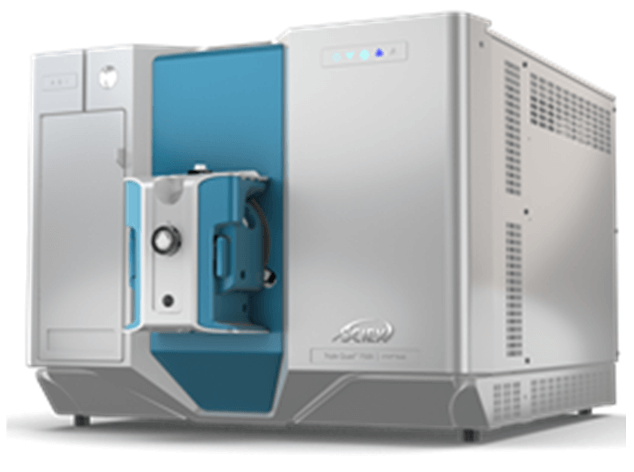
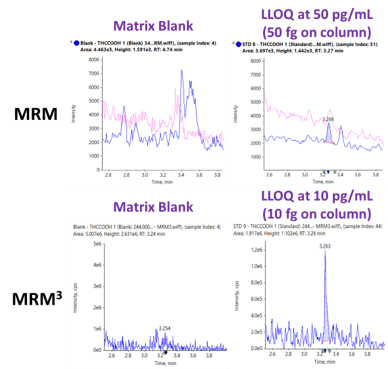 Click to enlarge
Click to enlarge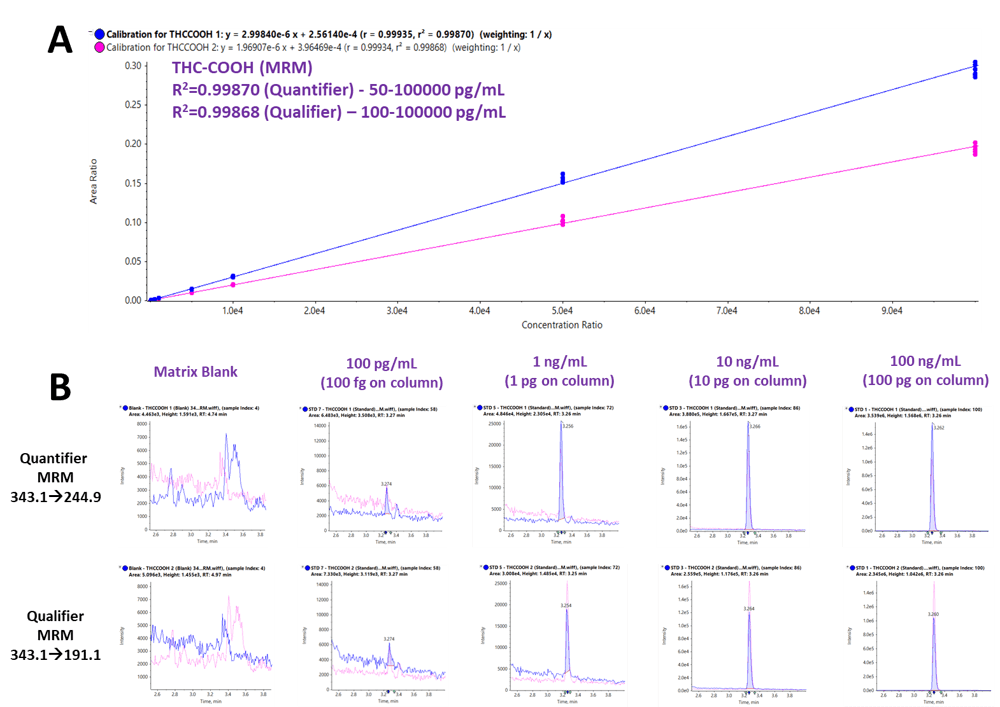 Click to enlarge
Click to enlarge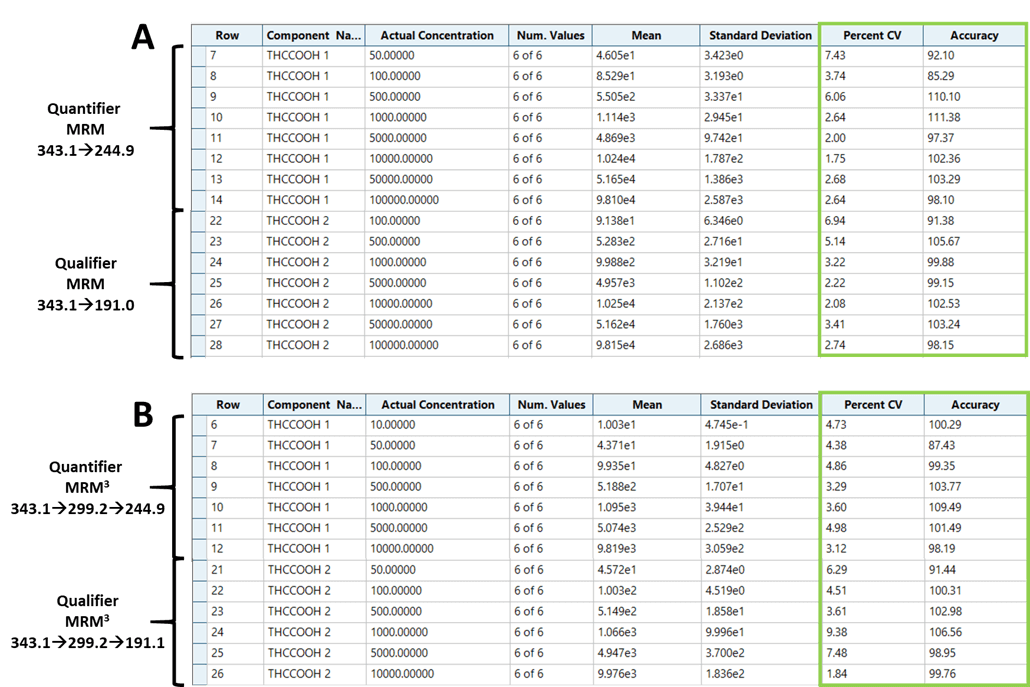 Click to enlarge
Click to enlarge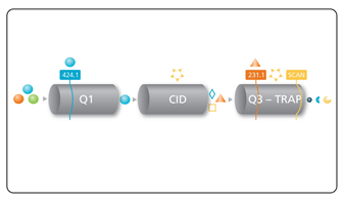 Click to enlarge
Click to enlarge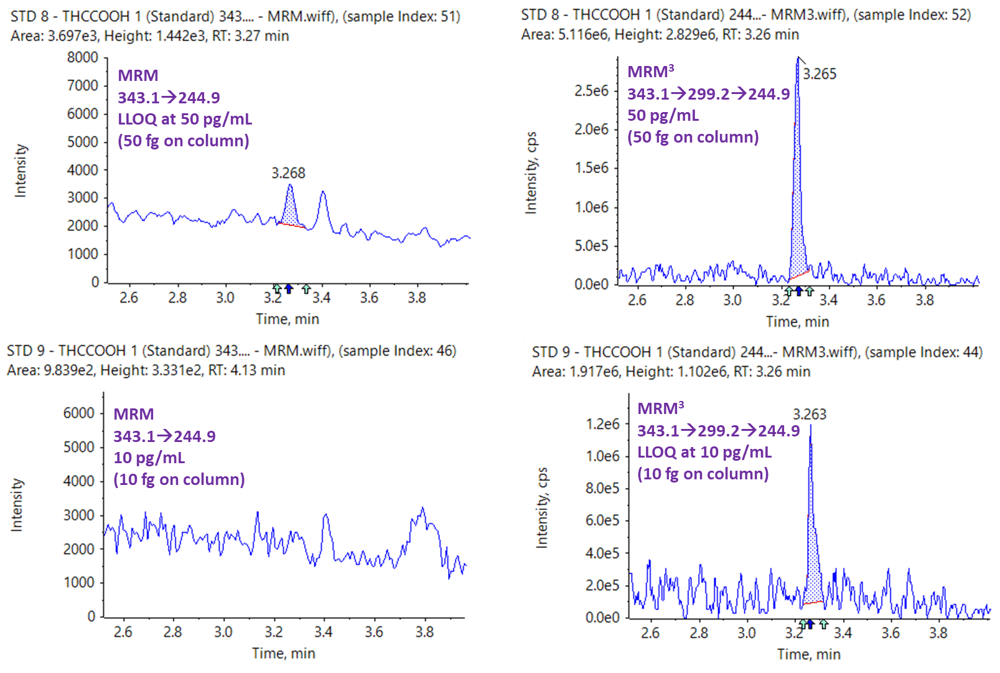 Click to enlarge
Click to enlarge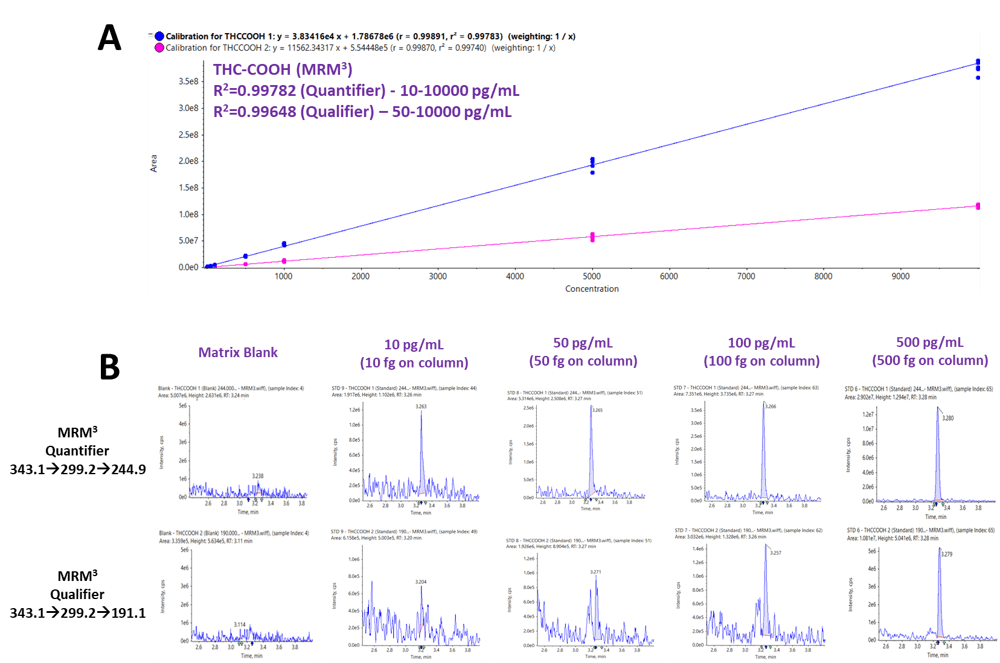 Click to enlarge
Click to enlarge